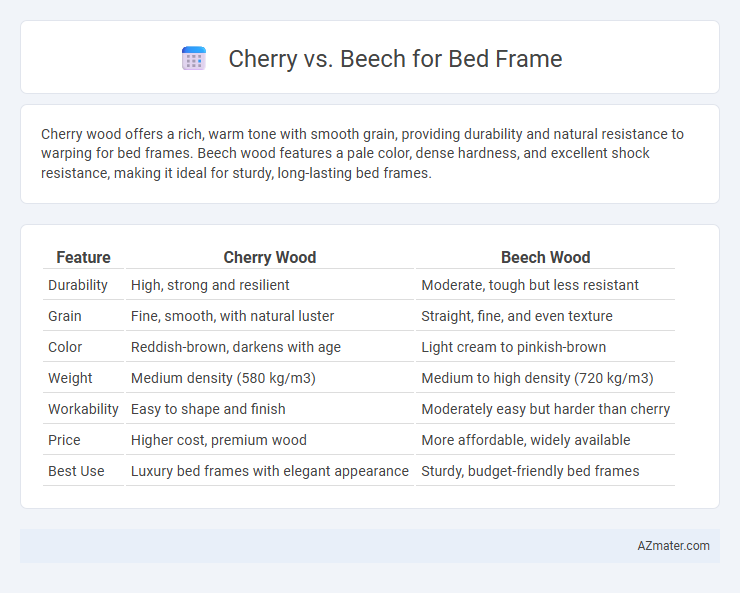Cherry wood offers a rich, warm tone with smooth grain, providing durability and natural resistance to warping for bed frames. Beech wood features a pale color, dense hardness, and excellent shock resistance, making it ideal for sturdy, long-lasting bed frames.
Table of Comparison
| Feature | Cherry Wood | Beech Wood |
|---|---|---|
| Durability | High, strong and resilient | Moderate, tough but less resistant |
| Grain | Fine, smooth, with natural luster | Straight, fine, and even texture |
| Color | Reddish-brown, darkens with age | Light cream to pinkish-brown |
| Weight | Medium density (580 kg/m3) | Medium to high density (720 kg/m3) |
| Workability | Easy to shape and finish | Moderately easy but harder than cherry |
| Price | Higher cost, premium wood | More affordable, widely available |
| Best Use | Luxury bed frames with elegant appearance | Sturdy, budget-friendly bed frames |
Introduction: Cherry vs Beech for Bed Frames
Cherry and beech are popular hardwood choices for bed frames, each offering unique qualities. Cherry wood boasts a rich, warm reddish-brown hue that deepens with age, providing an elegant and timeless appeal, while beech wood presents a lighter, more uniform color with exceptional strength and durability. Selecting between cherry and beech for a bed frame depends on desired aesthetics, hardness, and budget considerations.
Overview of Cherry and Beech Wood
Cherry wood, prized for its rich reddish-brown color and smooth grain, offers excellent durability and ages beautifully, developing a deep, warm patina over time. Beech wood features a pale cream color with a fine, consistent grain that provides strong structural stability and resistance to wear, making it a popular choice for robust furniture like bed frames. Both hardwoods are valued for their strength and aesthetic appeal, with cherry delivering a more luxurious finish and beech offering cost-effective resilience.
Appearance and Grain Patterns
Cherry wood boasts a rich, warm reddish-brown hue that deepens with age, featuring smooth, flowing grain patterns with occasional subtle curls and waves, providing an elegant and classic look for bed frames. Beech wood presents a lighter, creamy color with a fine, uniform grain that is straight and consistent, often displaying a subtle speckled pattern, resulting in a clean and modern aesthetic. The distinctive grain patterns and color variations of cherry emphasize sophistication, while beech offers a more understated and versatile appearance suitable for various bedroom styles.
Durability and Strength Comparison
Cherry wood offers excellent durability with a fine, tight grain that resists warping and dents, making it ideal for long-lasting bed frames. Beech wood is prized for its exceptional strength and hardness, providing a sturdy foundation that can withstand heavy use and weight over time. Both woods are durable, but beech typically surpasses cherry in terms of structural strength, making it the preferred choice for highly robust bed frames.
Weight and Workability
Cherry wood offers a moderate weight ideal for sturdy yet manageable bed frames, balancing durability with ease of handling during construction. Beech wood is heavier, providing enhanced strength and stability but requiring more effort in cutting and shaping due to its density. Both woods have excellent workability, though cherry's fine grain lends itself better to detailed craftsmanship and smooth finishes.
Cost Differences
Cherry bed frames typically cost more than beech due to the wood's rich color, fine grain, and slower growth rate, which increase material and craftsmanship expenses. Beech offers a more budget-friendly option while still providing durability and a smooth finish, making it a popular choice for cost-conscious buyers. Pricing for cherry bed frames often starts at $800, whereas beech frames can be found starting around $400, reflecting the significant cost difference.
Environmental Impact and Sustainability
Cherry wood offers a moderate environmental impact due to its slower growth rate and selective harvesting practices, promoting responsible forestry management. Beech wood is highly sustainable, sourced from fast-growing trees that regenerate quickly and support eco-friendly harvesting methods. Both woods provide durable options, but beech tends to have a lower carbon footprint owing to its rapid renewability and widespread availability.
Maintenance and Longevity
Cherry wood bed frames offer moderate maintenance with a natural resistance to wear and a rich patina that improves over time, while beech wood requires more frequent sealing and polishing to prevent moisture damage. Beech is a harder wood than cherry, providing greater durability and longevity under heavy use, making it less prone to dents and scratches. Both woods benefit from regular dusting and avoiding direct sunlight to maintain their appearance and structural integrity over decades.
Best Uses: Style and Bedroom Decor
Cherry wood offers a rich, warm reddish-brown hue that deepens with age, making it ideal for traditional and classic bedroom decor styles. Beech wood presents a lighter, creamy tone with a fine, even grain, complementing modern and Scandinavian bedroom aesthetics. Both woods provide sturdy durability, but cherry is preferred for elegant, antique-inspired frames, while beech suits minimalist, contemporary designs.
Conclusion: Which Wood is Better for Your Bed Frame?
Cherry offers rich color and smooth grain, providing a luxurious and warm aesthetic ideal for elegant bedroom designs. Beech is known for its durability, hardness, and lighter tone, making it a practical choice for sturdy, long-lasting bed frames. Choosing between cherry and beech depends on whether you prioritize aesthetic appeal or structural strength for your bed frame.

Infographic: Cherry vs Beech for Bed Frame
 azmater.com
azmater.com